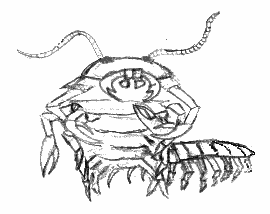
A giant centipede, this specimen was only 1 metre long. Interestingly the front four limbs of this species have become clawed. An adaptation that it found particuarly useful when feeding allowing it to be more alert than its cousins.
Arthropods were everywhere, as they are in our own world. However it was not the horror world of the B movie. While many were larger than their counterparts in our own world they were not significantly so. Arthropod physiology and their reliance on spiricles and booklungs for breathing has thankfully restricted the maximum size they can achieve. As has their reliance on a chitinous exoskeleton which cannot support the weight of an animal beyond a fairly small size. Although some arthropods were unpleasantly large.
Insects were very visible, particularly because they had near dominance of the air. Some of the dragonflies achieveing huge size the largest seen had a wingspan of almost 50cm. It was almost matched by a species of moth that was quite hummingbird like in its control as it hovered sipping nectar from flowers. Beatles patroled the ground, filling the detritovore niche. The old enemy of the insects was common too, everywhere the large webs of spiders were stretched between the vegetation.
 |
A giant centipede, this specimen was only 1 metre long. Interestingly the front four limbs of this species have become clawed. An adaptation that it found particuarly useful when feeding allowing it to be more alert than its cousins. |
Centipedes were one of the least pleasant creatures that we encountered. Some of them reached 2.5 metres in length, and could be 20 centimetres wide. Unlike the insects or arachnids which only have two or three segments the large number of segmented body parts a myriapod can have means that they can be very long. They can't be very thick otherwise they suffer the same problems as those other arthropods. however they were too large for my rather squeamish tastes.
Crustaceans were the most interesting of all the arthropods we observed. The habit of crustaceans of including some calcareous structures in their exoskeletons has allowed them on average to be larger than the insects. They also have by far the most advanced respitory system of any of the arthropods, which solves several of the problems restricting the size of these creatures. Most surprising was the adaptation seen in a couple of land crab species. The exoskeleton of the limbs of those crabs had gaps allowing more efficient muscle attachment. This may be the first step in the evolution of an endoskeleton by these creatures.